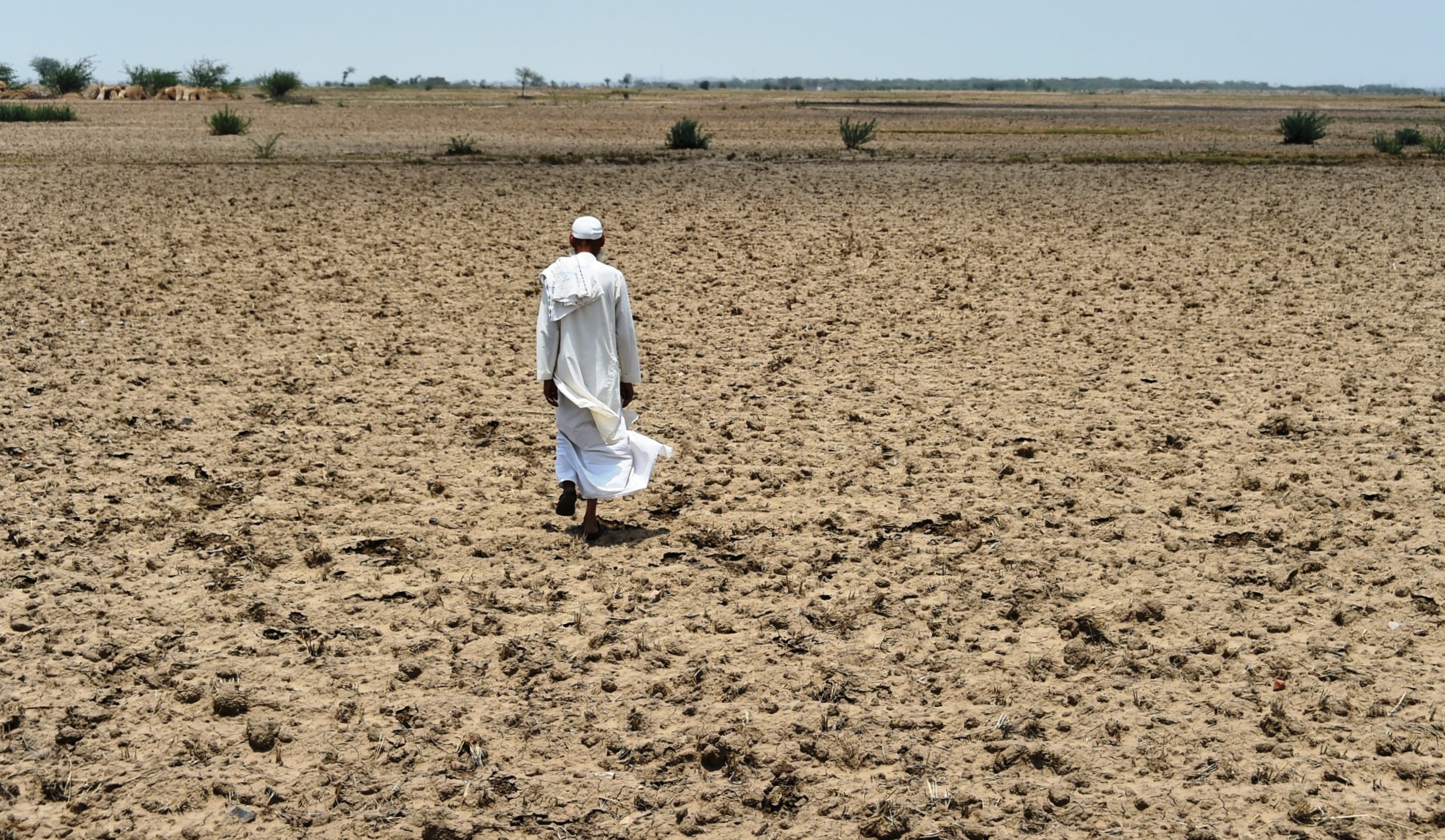
As per the Haryana Water Resources Authority around 3,000 of 6885 villages are water stressed while around two thousand others are headed for doom. The authority has identified 1,780 villages in the red category or severely groundwater stressed villages, reports Aayush Goel
His families have tilled this land for generations and even harvested bumper crops. The land paid for their celebrations and sorrows but 50 year old Shahabuddin has no option but to bid adieu to what he calls piece of his soul.
Despite all hope the water level in his village Pathkhori has dropped and a boring of 1200 feet is his last hope to keep his farms this year.
“We have tried for years waiting for irrigation channels or hoping that bore wells don’t go dry but water keeps going down every year. This time its 1200 feet and that’s our limit we can’t keep incurring this cost every year. My son will sell this land set up an auto workshop in Gurgaon. He says this will change our fate but not being a ‘kisaan’ will kill me,” he says.
Shahabuddin is not a lone case but is one among thousands of farmers in Mewat region who have long fought the water crisis but cannot brave the aqua doom engulfing them. The farmers in his neighbouring villages of Belond and Nangal have announced a mass sale of their lands as majority claim have no resources or patience to keep digging for water.
The CM Manohar Lal Khattar had recently visited Pathkhori village in district Nuh to encourage dam construction but that has failed to give much hope to desperate farmers.
“The water is below 1000 feet and it’s impossible to get it. We used tankers to manage crop somehow but it’s no longer feasible. The tubewells, borewells and ponds are going dry and majority of farmers are in no mood of sowing for next season so putting everything up for sale,” said local Sarpanch Zakir Khan.
Nuh, the quaint and most backward district of sterling state of Haryana still thrives on rain fed agriculture with 70 percent of villages with no irrigation facilities. Things have crawled fine for the district for years but went downhill since a decade. The water table has constantly been dipping since decade and entire Mewat stretched from districts of Nuh, Palwal, Faridabad upto Rajasthan is giving up with reduced water table levels at an average of 800 feets.
Disappearing Aravalis, reduced rainfall and unchecked commercialisation of cosmos like Gurugram doomed this agrarian region to aqua crisis which is now forcing many to give up farming.
“Visit any village of this district and all that you will find are dried ponds, water tankers parked in farms of big farmers and sale notices on farm lands. We are an agrarian district but despite all tall promises of government, 70 percent has no irrigation facility. The underground water is depleting and local farmer can no longer sustain himself,” says Nuh MLA Aftab Ahmed.
Ironically it’s not tale of just one cluster of villages but as per the Haryana Water Resources Authority around 3,000 of 6885 villages are undergoing water crises while around two thousand others are headed for doom. The authority has identified 1,780 villages in the red category or severely groundwater stressed villages. In these villages, the extraction of groundwater is far greater than the recharge, taking their water table down to more than 30 metres. Similarly, 1,041 villages have been categorised as pink zone with the groundwater table at more than 20 metres. As many as 1,807 villages have been identified in potential groundwater stressed category with water table in range of 10-20 metres. The state has only 1,261 good groundwater potential villages
14 out of 22 districts water stressed; Kurukshtera worst
Fourteen of the 22 districts of Haryana are battling water crisis as the annual groundwater withdrawal in Haryana is 137% of its annual extractable groundwater resources which is the third-highest in the country. The national average is at 63%. Ironically topping the charts of Ground water crisis is agriculturally prosperous district of Kurukshetra, which, all thanks to Paddy cultivation, has now gone down to using its static water and headed to be without ground water soon. In Kurukshetra district, 422 villages are severely groundwater stressed spots. The groundwater level has depleted by up to 13 meters since 2010 in these villages. There is a shortfall (water gap between availability and extraction) of about 500 million cubic meters of water per year in Kurukshetra. The second in list is Mahendergarh with 308 red zone villages. Kaithal district is third worst affected district with 170 such villages. Districts of Fatehabad and Sirsa have 151 and 103 such villages in the red zone. Gurugram has 99 villages in red zone. Bhiwani has 96 villages categorised as red zones. Rewari district has 91 water stressed villages. The water overexploitation has been found in 85 of the 141 blocks in the state.
Paddy Cultivation a major challenge
While there is a lack of irrigation facility for districts like Nuh, for the majority its lure of Paddy cultivation. Currently the state has around 14 lakh hectare land under the paddy crop in Haryana. The area under paddy in Haryana went up sharply from 8.5 lakh (850,000) hectares in 1996 to 13.87 lakh (1.38 million) hectares in 2018, before coming down to 12 lakh (1.2 million) hectares in 2020-21 and has increased ever since. Haryana produces about 68 lakh MT of paddy, including over 25 MT of the basmati variety, across the state. The government under the Mera Pani-Meri Virasat Scheme is offering Rs 7,000 per acre to the farmers for sowing alternate crops in place of paddy to save water for irrigation purposes. Same amount is also being given under ‘Khet Khali fir bhi Khushali’ scheme if farmers don’t sow anything and leave land empty in Paddy season. However with a well oiled MSP Mechanism not many are ready to give up. Thus the farmers have this year been offered to switch to Direct Seeding of Rice or DSR. The department will give an incentive of Rs 4,000 per acre to farmers opting for the DSR technique through direct benefit transfer. The technique involves the direct seeding of rice rather than the conservative transplantation method. It requires lesser use of water, labour and power, and is considered a better technique for the depleting water table. But the reluctance of the farmers to leave conservative methods for adopting newer ones and excessive weeds in this technique are the major issues, besides the timely availability of the DSR machines. The government has set targets of 7,000 acre for Ambala; 6,000 acre each for Yamunanagar, Panipat and Sonepat; 10,000 acre each for Karnal and Kurukshetra; 11,000 acre each for Kaithal and Jind; 9,000acre for Fatehabad; and 8,000 acre each to Sirsa, Hisar and Rohtak districts. An amount of Rs 40 crore has been allocated under the scheme.
Not just water scarcity but water logging too pushing out farmers
While Fourteen districts struggle with low water tables, those of Jhajjar, Rohtak and Charkhi Dadri are dealing with water logging and ground water salinity. There are 85 villages in Haryana that are severely waterlogged, having water table depths of less than 1.5 metres. 19 villages in Haryana are potential waterlogged villages, with water table depths ranging from 1.5 to 3 metres.
Jasvir Kalkal, 39, a farmer who owns over 15 acres of land in Imlota village has put it up for sale.
“The village land used to be quite fertile but love for paddy disturbed our water table and today our fields are nothing but saline marshes. No matter what we do, we have to soon give up and sell these prized land of ours,” says Kalkal.
Continuous sowing of paddy by the farmers, over a long period of time, upset the groundwater table and it raised to 2 feet below the ground from being at a depth 20 feet in 2008.
Imlota is a part of a cluster of seven villages in Haryana’s Charkhi Dadri district, that have been facing perennial water logging issues since 2008. The other six villages are Swaroopgarh, Sattor, Morwala, Kanheti, Bigowa and Badvi.
Trying to deal with this issue the government has invited applications from farmers in Jhajjar, Rohtak and Charkhi Dadri, applications have been invited from farmers who want to free their land from salinity and waterlogging. The farmers would have to bear 20 percent of the cost while the rest would be borne by the government. The state government is also considering adopting vertical farming technology and farmers are encouraged to adopt crop diversification and irrigate land through sprinklers, replacing the traditional flooding method. The panchayats have been given free land to be leased out for fisheries.
Fighting tooth and Nail
The state has woken to the aqua crises which threatens its very core and went on to set up Haryana Water Resources (Conservation, regulation and Management ) Authority in 2020. The authority also has started a proper water audit, for which 1,700 piezometers are being installed in critical red blocks for real-time monitoring of the groundwater table. The state has gone ahead with plans of reviving 8000 village ponds in the first phase of the Amrit Sarovar project. The government has mooted a plan to construct six small dams in Morni (Panchkula) area of Shivalik hills in the coming year, a similar number of dams were constructed earlier too under Kandi project.
Haryana is the best-performing state in the country in terms of implementation of the Atal Bhujal Yojana. The main objective of this scheme is to create hydrological data of ground water resources and reduce scarcity by almost 50 percent. Water stressed zones of 14 districts have so far been covered.
“We have reached a stage where we need to focus on water usage efficiency and concentrate on rationalisation of use of groundwater through methods like micro-irrigation and crop diversification. There is also a dire need to increase recharge points or digging the canals to prevent the groundwater from further depletion. We have come a long way in two years with point wise identification of water issues and resolution. So while on one hand we are working on recharging and maintaining water tables we are also dealing with salinity and water logging . Things have improved showing encouraging results in many areas and we hope to stabilize the issue soon ,” said Keshni Anand Arora, Chairperson, Haryana Water Resources Authority .












